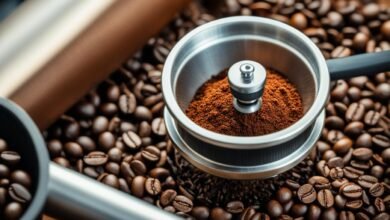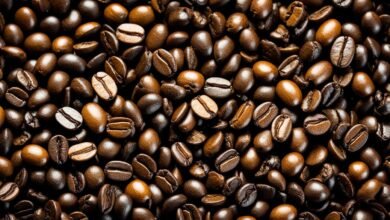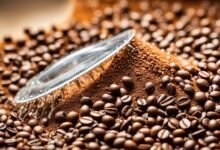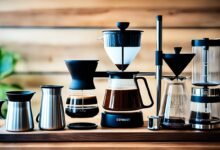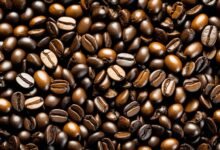Brewing Techniques for Different Coffee Makers
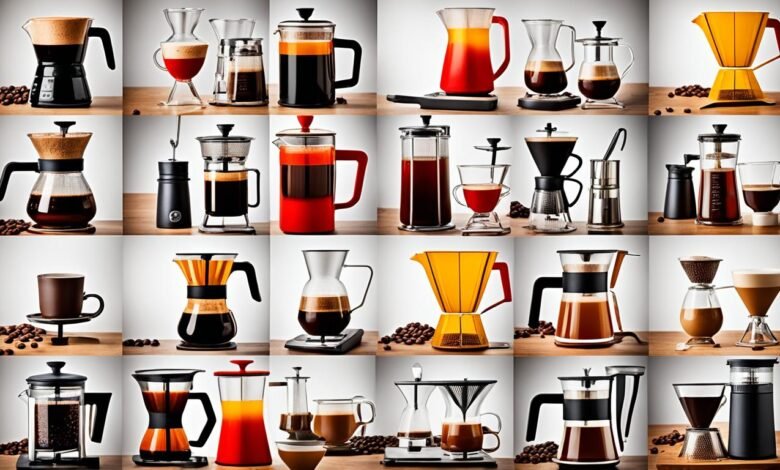
I love exploring the art of brewing the perfect cup of coffee. From the rich, velvety crema of espresso to the clean, bright flavors of pour-over, each method has its own special taste. In this guide, we’ll look at various coffee brewing techniques. We’ll talk about their benefits, best practices, and unique flavors.
If you’re a coffee expert or just starting out, this article will help you improve your home coffee. We’ll cover pour-over, French press, espresso, AeroPress, auto-drip, cold brew, Moka Pot, and siphon brewing. You’ll learn how to find your favorite brewing method and bring out the best in your coffee beans.
Key Takeaways
- Explore a variety of coffee brewing techniques, from classic pour-over to innovative AeroPress
- Understand the unique characteristics, benefits, and best practices of each brewing method
- Discover the distinct flavor profiles and brewing times associated with different coffee makers
- Learn about the history and evolution of popular brewing devices like the Chemex and Moka Pot
- Gain insights to elevate your home coffee experience and find your personal brewing preference
Introduction to Coffee Brewing Methods
Making the perfect cup of coffee is like an art. It’s all about knowing the different brewing techniques. From espresso’s bold taste to pour-over’s smooth notes, each method has its own charm. It’s key to pick the right technique and think about what makes each one special.
The Importance of Choosing the Right Brewing Technique
The brewing method you pick changes how your coffee tastes, feels, and looks. Each method brings out unique flavors from the beans. Knowing the strengths and limits of each method lets you make coffee just how you like it.
Factors to Consider When Selecting a Brewing Method
- Personal preference: Do you enjoy bold, intense flavors or prefer a more subtle, delicate taste?
- Convenience: How much time and effort are you willing to invest in the brewing process?
- Group size: Are you brewing for a single cup or a larger gathering?
- Flavor profile: What specific flavor characteristics are you trying to highlight in your coffee?
Think about these things to pick a brewing method that’s just right for you. Whether you’re a pro or just starting, knowing about coffee brewing methods helps you get the best out of your brewing technique and selecting brewing method.
Pour Over Coffee Brewing
For coffee lovers, the pour over method is a top pick. It lets you control the brewing for the best flavors from your beans. By pouring hot water over ground beans, you get a clean, bright, and balanced coffee.
Understanding the Pour Over Technique
The pour over method involves pouring hot water over coffee grounds in a special pot. You can use a Chemex, Hario V60, or Kalita Wave. This method needs focus, as the water temperature, pouring way, and brew time affect the coffee’s taste.
Popular Pour Over Brewers: Chemex, Hario V60, Kalita Wave
- The Chemex has a unique hourglass shape and paper filters for a clean coffee taste.
- The Hario V60 has a cone shape with a spiral hole for even extraction and a balanced flavor.
- The Kalita Wave has a flat bottom with many holes to prevent uneven extraction and create a smooth taste.
Each pour over brewer has its own special features. This lets coffee fans try different ones to find their favorite. The pour over method takes more effort, but it’s worth it for a top-notch coffee.
“The pour over method is a true labor of love, allowing you to craft a cup of coffee that’s as unique as the beans themselves.”
French Press Coffee Brewing
The French press is famous for making a strong, full-bodied cup of french press coffee. It works by soaking the coffee grounds in hot water and then pressing the grounds to the side. This method keeps the coffee’s natural oils and flavors. It makes a rich, complex coffee that’s great for those who like a bold taste.
For French press, use 60-70 grams of coffee for every liter of water. This means a ratio of 1:16 to 1:14. Aim for a brew time of 6 to 8 minutes, not just 3 to 4, to get the best flavor with a coarse grind.
French press is easy and doesn’t require much precision, unlike drip or pourover methods. It uses mesh filters to keep the grounds back, but some fine particles might stay in the coffee. This adds to the coffee’s richness and thickness.
This method takes a bit longer but gives you a coffee with deep sweetness and a thick body. To get the taste you like, try different grind sizes, water temperatures, and brew times. It’s more forgiving than quicker methods.
| French Press Size | Recommended Coffee Beans | Brew Time |
|---|---|---|
| 32 ounces (4 servings) | 1 cup (8 tablespoons) | 6-8 minutes |
For French press, use pre-ground beans that are like breadcrumbs in texture. The standard ratio is 1 gram of coffee for every 16 grams of water, or 1:16. You can try different ratios like 1:15 or 1:17 to find what you like best.
“The French press brewing method does not require precise pouring techniques, unlike other coffee-making methods that might recommend the use of a gooseneck kettle.”
French press coffee doesn’t need a paper filter because the plunger acts as one during brewing. But, don’t leave the coffee in the press after pressing, or it might taste bitter. The coffee’s unique flavor comes from the oils and sediment that aren’t filtered out.
Espresso Brewing
Espresso is a strong type of coffee made by pushing hot water through finely ground beans under pressure. This method brings out the coffee’s natural tastes, making a thick, syrupy drink with a creamy top. Knowing how espresso is made helps get the perfect mix of sweet, sour, and rich flavors in your drink.
The Science Behind Espresso Extraction
Grind size, water temperature, and pressure are key to making espresso. Baristas use these factors to get the best flavors from the beans. A finer grind, hotter water, and more pressure make the espresso stronger and tastier.
Choosing the Right Coffee Beans for Espresso
For espresso, pick beans with a strong, full taste that can handle the brewing process. These beans are roasted to a medium-dark or dark level to bring out their sweetness and depth. Blends from different places and ways of making beans can also make a great espresso.
Understanding espresso’s science and choosing the right beans are key to a great espresso. By grasping these ideas, coffee lovers can bring out the best in this popular coffee type.
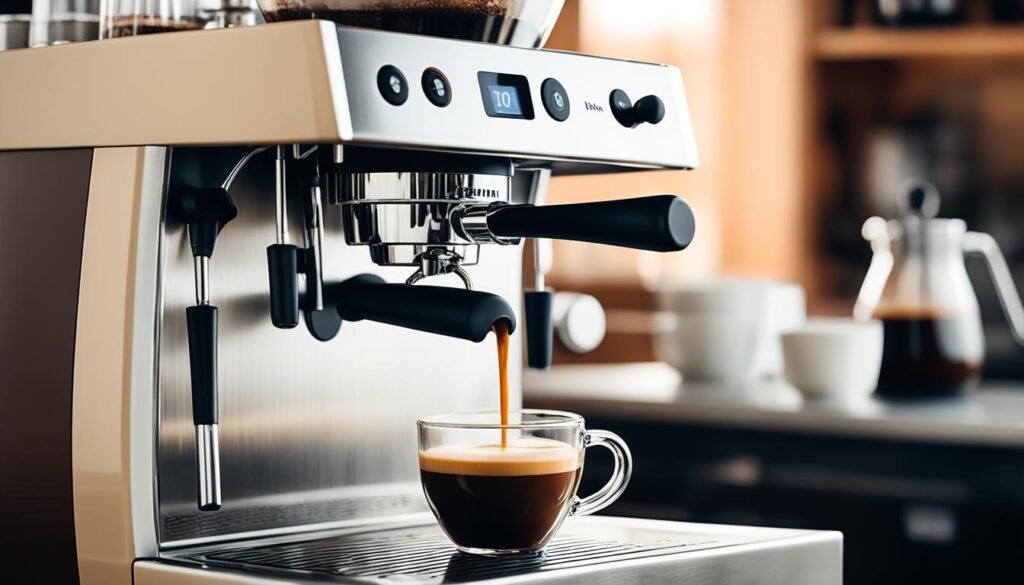
“Espresso is the foundation of many great coffee drinks, and mastering its preparation is the key to unlocking a world of rich, flavorful coffee experiences.”
AeroPress Brewing
The AeroPress is a unique coffee maker that blends the ease of a French press with the accuracy of a pour over. It uses a plunger to push hot water through a paper filter. This method makes a clean, strong coffee with a smooth taste. It’s great for those who love coffee and are always on the move or have little space.
Portability and Convenience of the AeroPress
The AeroPress is small and easy to use, perfect for travelers, campers, or anyone with little kitchen space. It can make coffee in sizes from 8 to 20 ounces. The AeroPress comes in various models, each with its own accessories like a carafe and filters.
It’s super light, weighing just a few ounces, making it the easiest coffee maker to carry around. Setting it up is quick and simple, with no complex parts or big equipment. It’s ideal for anyone needing a quick coffee fix, whether in the wild or at work.
| AeroPress Model | Capacity | Accessories | Price |
|---|---|---|---|
| AeroPress Coffee Maker – Go | 8 oz | Tumbler with built-in filter holder, Lid, Stirrer, Scoop, Paper Micro-Filters | $49.95 |
| AeroPress Coffee Maker – Original | 10 oz | Paper Micro-Filters, Stirrer, Scoop | $39.95 |
| AeroPress Coffee Maker – XL | 20 oz | 20 oz Carafe, XL Paper Micro Filters, XL Stirrer | $69.95 |
| AeroPress Coffee Maker – Clear | 10 oz | Paper Micro-Filters, Stirrer, Scoop | $49.95 |
With over 55,000 five-star reviews in more than 60 countries, the aeropress coffee maker is a top pick for coffee lovers. It’s great for making American-style coffee, cold brew, or espresso-style drinks. The AeroPress is known for its delicious coffee and being easy to take anywhere.
“The AeroPress is the most portable coffee brewer in existence, making it the perfect companion for coffee lovers on the go.”
Brewing, Techniques, Different Coffee Makers
There’s no one way to make a great cup of coffee at home. Each brewing method, like pour over or French press, has its own special qualities. By learning about these methods, we can pick the one that fits our taste and lifestyle best.
The pour over method starts with wetting the grounds for 30 seconds to bring out flavors. It uses water at about 200°F (93°C) for the best taste. French press, however, steeps coarse grounds in hot water for a few minutes. This makes a rich, full-bodied coffee with oils from the beans.
| Brewing Method | Ideal Water Temp. | Brew Time | Grind Size | Flavor Profile |
|---|---|---|---|---|
| Pour Over | 200°F (93°C) | 3 minutes | Medium | Bright, complex |
| French Press | 195-205°F (91-96°C) | 4-5 minutes | Coarse | Smooth, robust |
| Espresso | 195-205°F (91-96°C) | 25-30 seconds | Fine | Intense, concentrated |
| AeroPress | 175°F (80°C) | 1-2 minutes | Medium-fine | Bright, clean |
| Cold Brew | Cold | 12-24 hours | Coarse | Smooth, less acidic |
Whether you want a quick brew or a hands-on experience, there’s a method for you. By exploring these techniques, we can make our coffee at home even better. This lets us dive into the world of specialty coffee like never before.
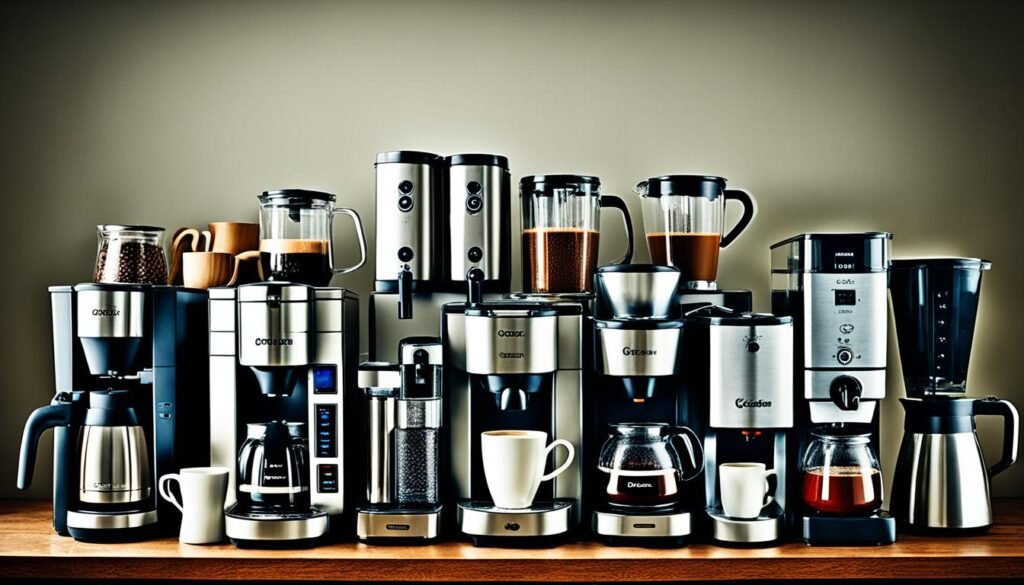
“The true alchemy of coffee lies in the brewing process itself. Each method has the power to unlock a unique flavor profile, creating a captivating sensory experience.”
Auto-Drip Coffee Makers
Auto-drip coffee makers are a top choice for home brewing. They make brewing a full pot of coffee easy and automatic. These machines are great for many households because they’re easy to use. But, it’s good to know the good and bad about them.
Advantages of Auto-Drip Coffee Makers
- Ease of use: Auto-drip machines make brewing simple with just one touch. They don’t need much help from you.
- Larger batch sizes: These machines can make up to 12 cups at once. They’re perfect for big families or filling a travel mug.
- Consistent performance: They use set brewing cycles for a reliable cup of coffee every time.
Disadvantages of Auto-Drip Coffee Makers
- Limited control over brewing variables: You can’t change things like water temperature or coffee strength as much as with manual brewing.
- Potential for over-extraction: The automated brewing can sometimes make the coffee taste bitter or burnt.
- Maintenance requirements: To work well, these machines need regular cleaning and descaling to stop mineral buildup.
Auto-drip coffee makers are popular for their ease and consistent results. They don’t offer the same control as manual brewing, but they’re great for a full pot with little effort. Knowing the pros and cons can help you pick the best coffee maker for you.
| Auto-Drip Coffee Maker Model | Price Range |
|---|---|
| ZWILLING Enfinigy Glass Drip Coffee Maker | $150 |
| Chemex Ottomatic 2.0 | $350 |
| Oxo On Barista Brain 9-Cup Coffee Maker | $230 |
| Bonavita One-Touch Coffee Maker | $300 |
| Cuisinart Perfectemp | $100 |
| Cuisinart Classic Thermal | $130 |
| Breville Precision Brewer Thermal | $330 |
| Hamilton Beach BrewStation | $55 |
| Calphalon 14-Cup Programmable | $90 |
| Ninja 12-Cup Programmable | $68 – $90 |
| Amazon Basics 12-Cup Digital | $35 |
| Mr. Coffee 10-Cup Programmable | $80 |
| Black & Decker 12-Cup Coffee Maker | $60 – $63 |
Cold Brew Coffee Brewing
Cold brew coffee is a favorite for those who love a smooth, low-acidity coffee. It’s made by steeping coarse coffee grounds in cold water for 12-24 hours. This method brings out the coffee’s sweetness and complexity, leaving out the bitterness and acidity. The result is a refreshing and aromatic coffee perfect for hot summer days.
The Basics of Cold Brew Coffee Making
The secret to great cold brew is the long steeping time and the use of low temperatures. By letting the coffee steep for a long time, the cold brew process pulls out the best flavors. This creates a concentrated coffee that you can dilute with water or milk. It’s a great choice for those who like a smoother, less bitter coffee.
To brew cold coffee at home, you’ll need a few things:
- Coarsely ground coffee beans
- A cold brew coffee maker or a French press
- Filtered water
- A container for steeping and storing the cold brew
The right coffee-to-water ratio is 1:5.33, or about 12 ounces of coffee to 64 ounces of water. After gathering your ingredients, mix the coffee and water in your brewing container. Let it steep for 12-24 hours, then strain the concentrate to enjoy your refreshing cold brew coffee.
| Cold Brew Coffee Maker | Price |
|---|---|
| Hario Mizudashi Cold-Brew Coffee Pot | $20 |
| Takeya Deluxe Cold Brew Coffee Maker | $25 (Amazon), $28 (Target) |
| Bruer Grey Cold Drip Coffee System | $80 (Amazon) |
| Kaffé KF9040 Cold Brew Coffee Maker | $30 (Kaffe) |
| Kaffé KF9020 Cold Brew Coffee Maker | $30 (Kaffe), discounted to $25 |
| Coffee Gator Cold Brewer | $20 (Amazon) |
There are many cold brew coffee makers to choose from, for every budget and taste. Whether you pick a simple Hario Mizudashi or a complex Bruer system, the key to perfect cold brew coffee is the process.

Moka Pot Brewing
The Moka Pot is a key part of Italian coffee culture, dating back to 1933. Alfonso Bialetti created this stovetop espresso maker. It’s simple and affordable, letting people enjoy a strong, espresso-like coffee.
The History and Tradition of the Moka Pot
The Moka Pot is known for its unique design and flavorful brew. In 1933, the Moka Express Bialetti was introduced, changing coffee brewing. It uses pressure to force hot water through coffee grounds, unlike other makers that rely on gravity.
Today, the Moka Pot is still loved by coffee lovers. It’s made of aluminum or stainless steel and has a safety valve. For the best coffee, use fresh beans and a fine grind size.
“The characteristic sputtering sound of the Moka Pot signifies the completion of the brewing process, delivering a rich, concentrated beverage that captures the essence of Italian coffee culture.”
The moka pot brewing method makes coffee much stronger than regular brews, with a 1:7 ratio. This method is less pressurized than espresso machines but still makes a unique, tasty coffee.
The Moka Pot’s history and popularity show its lasting appeal. It’s great for both coffee experts and beginners. Exploring its traditions and methods is a fun and tasty journey.
Siphon Coffee Brewing
Siphon, or vacuum, coffee brewing is a fascinating method that blends art and science. It was invented in the 1840s in Germany. This method uses vapor pressure and gravity to move water up into a chamber with coffee grounds. Then, it pulls the brewed coffee back down through a filter.
This process makes a delicate, nuanced cup with a clean flavor. The siphon’s design and the ritual of brewing have made it popular. Coffee lovers and baristas enjoy the skill needed to make it.
The Science and Technique of Siphon Coffee Brewing
To make perfect siphon coffee, use a 1:15 coffee to water ratio. The bulb should hold 300g of water. You’ll need 20g of medium-coarse coffee grounds for one serving.
The brewing takes about 2 minutes 30 seconds to 3 minutes. Stir the coffee blend 10 times during the process. It’s important to control the heat to avoid bitterness. You can use a butane burner, a halogen lamp, or a candle, but a butane burner is easiest to find.
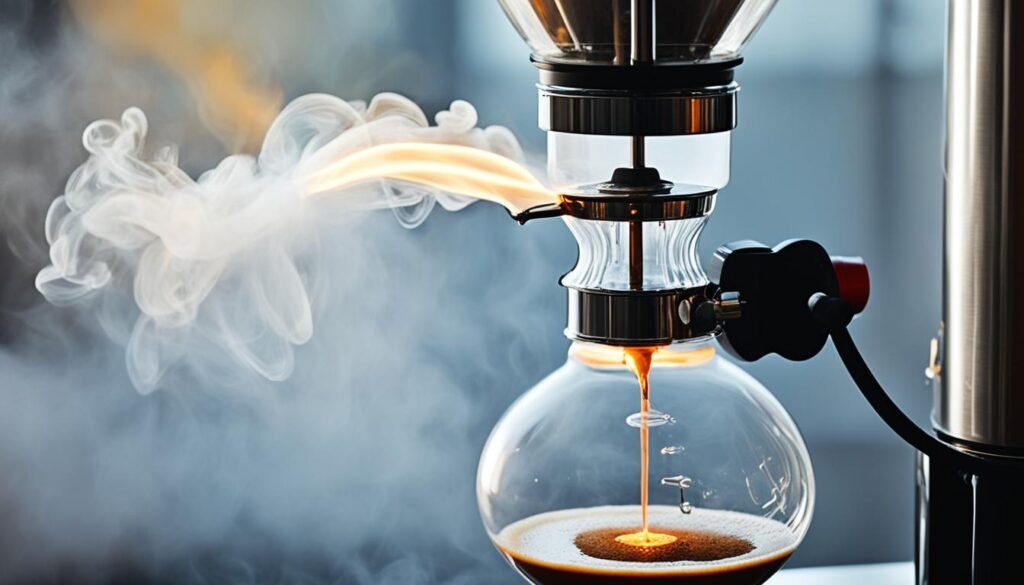
Not many coffee lovers use the siphon as their main brewing method. Yet, it’s a favorite for those who value its unique art and science. Its visual appeal and the skill needed to brew it enchant coffee lovers worldwide.
Coffee Brewing Essentials
Making the perfect cup of coffee is more than just picking the right brewing method. Essential factors like grind size, water temperature, and fresh beans greatly affect your coffee’s quality and taste. Let’s look at how these factors impact your coffee.
Grind Size and Water Temperature Considerations
The grind size you need depends on the brewing method. A finer grind is best for espresso, while a coarser grind is better for pour-over and French press. Aim for one to two tablespoons of ground coffee per six ounces of water.
Also, keep the water temperature right, between 195°F and 205°F. This temperature is key for getting the right flavors and oils from the beans.
The Importance of Fresh Coffee Beans
For the best coffee, use fresh, high-quality beans. Buy coffee in small amounts, every one to two weeks, for freshness. Don’t reuse coffee grounds as they can make your coffee taste bitter and old.
Grind the beans right before brewing to keep the aroma and flavor. This is the best way to enjoy your coffee’s true taste.
“The key to a great cup of coffee is finding the right balance between the grind size, water temperature, and the freshness of the beans.”
Focus on these key brewing factors to make delicious coffee that suits your taste. Try different grind sizes, water temperatures, and bean freshness to find your perfect cup.
Conclusion
In this guide, we’ve looked at many coffee brewing techniques and methods. Each has its own benefits and things to think about. From the precise pour over to the strong espresso, and the easy auto-drip to the creative siphon brewing, there’s a method for every taste and lifestyle.
Understanding these brewing ways lets you try new things, find what you like, and make your home coffee better. Whether you love coffee or are just getting into it, learning these methods can make every cup perfect. You can go from simple drip coffee to the detailed pour-over, or from the full French press to the smooth AeroPress.
Remember, important things like water temperature, coffee-to-water ratio, and how long to extract matter for great coffee. So, start experimenting and find the joy of making the perfect coffee for you. Your coffee adventure is just beginning!
